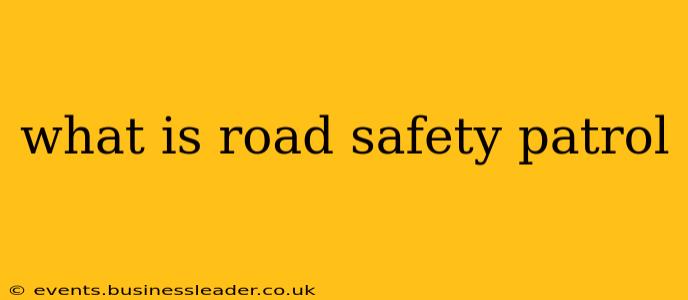Road Safety Patrols are volunteer programs, typically involving students from elementary and middle schools, aimed at improving safety for students walking or biking to and from school. These patrols aren't about enforcing laws or issuing tickets; instead, they focus on educating their peers and promoting safe pedestrian and cyclist behavior. Think of them as a proactive layer of safety, supplementing the efforts of school staff, parents, and local law enforcement.
What are the responsibilities of a road safety patrol?
Road safety patrol members typically perform a variety of tasks depending on their age and the specific program guidelines. Common responsibilities include:
- Controlling Crosswalks: Guiding students safely across streets at designated crosswalks, ensuring they wait for appropriate gaps in traffic and look both ways before crossing.
- Assisting with Traffic Flow: Helping to manage pedestrian traffic around the school, particularly during busy times like arrival and dismissal. This can involve directing students to use designated walkways and preventing congestion.
- Educating Peers: Promoting safe walking and cycling habits among their classmates. This might involve reminding students to wear bright clothing, use bike helmets, and avoid distractions while walking or cycling.
- Reporting Hazards: Identifying and reporting any potential safety hazards near the school, such as potholes, poor visibility, or reckless driving.
Who runs Road Safety Patrols?
Road Safety Patrols are often organized and overseen by:
- Schools: Many schools manage their own programs, training students and providing necessary equipment.
- Local Law Enforcement: Police departments or school resource officers sometimes provide training and support to the patrols.
- Community Organizations: Local organizations, such as parent-teacher associations (PTAs) or community safety groups, may assist in organizing and supporting the patrols.
What are the benefits of a Road Safety Patrol?
The benefits of a Road Safety Patrol extend beyond just improving student safety; they also offer valuable learning experiences for the participating students. These benefits include:
- Enhanced Student Safety: The primary benefit is, of course, a significant reduction in accidents near the school.
- Leadership and Teamwork Skills: Patrol members develop leadership and teamwork skills by working together to ensure the safety of their peers.
- Community Involvement: Participating in the patrol fosters a sense of community responsibility and civic engagement.
- Responsibility and Maturity: The responsibility of ensuring the safety of others helps students develop maturity and a sense of responsibility.
- Improved Awareness of Road Safety: Patrol members gain a deeper understanding of road safety and the importance of following traffic rules.
How do students become part of a Road Safety Patrol?
The process for joining a Road Safety Patrol varies depending on the school and community. Typically, students apply and are selected based on:
- Age and Grade Level: Usually, older, more mature students are selected.
- Responsibility and Maturity: Demonstrated responsibility and maturity are essential qualities.
- Commitment: Students need to be committed to attending patrols regularly.
- Training: Successful applicants usually undergo some form of training on safety procedures and traffic rules.
What equipment do Road Safety Patrols use?
The specific equipment used varies, but commonly includes:
- Brightly Colored Vests or Jackets: To ensure patrol members are highly visible to drivers and other students.
- Stop Signs or Flags: To signal to traffic to stop or slow down.
- Whistles: To alert students and drivers to potential hazards.
- Walkie-Talkies (in some cases): For communication between patrol members.
Road Safety Patrols are a valuable community asset, contributing to the safety and well-being of students and the broader community. Their proactive approach to safety education and hazard mitigation makes them an essential part of many schools' safety plans.
